A lot of you may have seen little round balls or caps sticking out of your plant’s soil. This is actually not an uncommon encounter. These are mushrooms, a fungus that thrives in healthy and/or moist soil. Unlike plants, they have no chlorophyll to make their own food, so they rely on a plant’s nutrition (alive or dead) to survive. Read on and find out about mushrooms in your houseplants why they are a good sign.

Most people may freak out when they hear this as they associate it with the negative connotations of fungi such as molds and parasites. While it is true that both molds and mushrooms are fungi, these are two different things.
In this article, we will read more about the most common what’s, where’s, why’s, and how’s of mushrooms in relation to your houseplant. Let’s get started!
How Do Mushrooms Grow?
A lot of mushrooms can be freaky and ubiquitous. You may see them growing in an old log in your backyard, in the forest, in parks, and even in decaying plants.
They don’t grow as much as plants do. In addition to what was mentioned above, they also don’t have seeds, unlike most plants. Instead, they reproduce through their spores which attach to a nutrient source such as roots, dead plants, or dead animals.
This doesn’t mean though that they are feeding off the life of your plants. In fact, this is quite the opposite, as they have a symbiotic relationship with plants, particularly at the root level.
What Causes These Mushrooms To Grow In Your Houseplant Soil?
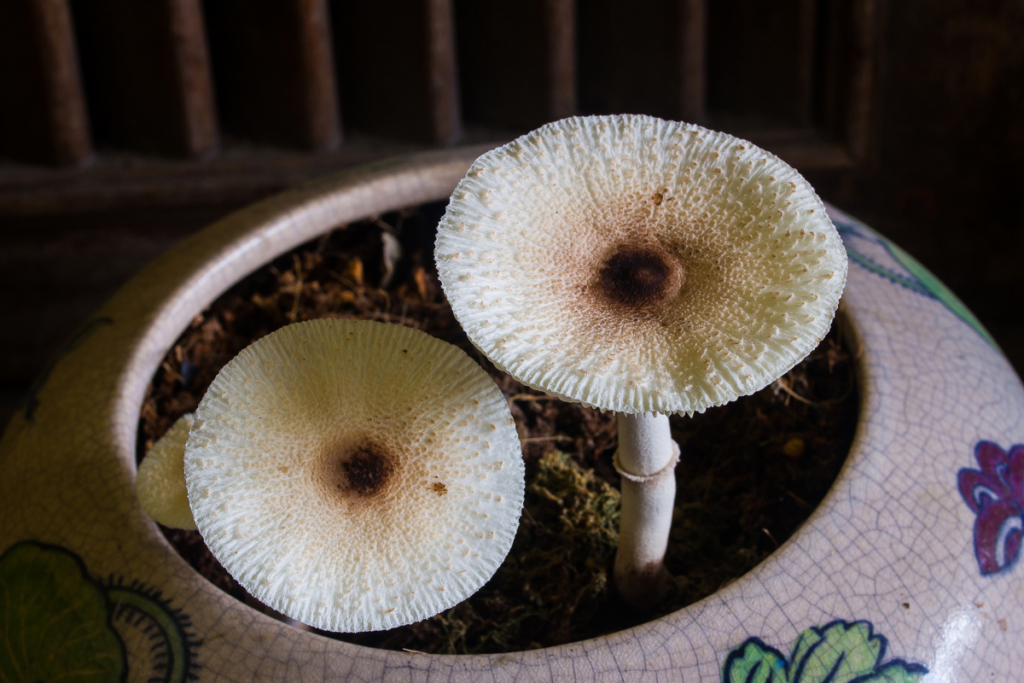
Plantpot dapperling do not just automatically sprout whenever and wherever. But, of course, the proper environmental conditions that push their growth must first be met. So here are the probable reasons why you have them in your contaminated potting soil:
Extreme Humidity
Mushrooms, like your Flowerpot parasols, hail from the tropical and subtropical regions, which also include some cold areas such as North America, Europe, and Australia. So, depending on your location, you can possibly see these yellow mushrooms in your gardens.
A high humid level and warm place is not just a thriving environment for your tropical house plants but also for your little yellow mushrooms. So expect to see these mushrooms in your indoor plants’ soil.
Overwatering
The presence of water increases humidity. Hence an overwatered plant will surely attract yellow houseplant mushrooms. As said before, mushrooms thrive in a humid environment and aggressively grow since it is optimum for them.
However, this is the least of your problems since overwatering is often the lead cause of root rot, potentially killing your plant. In addition, plants’ roots that are soaked in water for an extended period of time get suffocated due to a lack of oxygen and drainage. As a result, they can become oversaturated, which can lead to death.
Nutrient-Rich Potting Mix
Mushrooms love feeding on decaying organic matter; however, it’s more likely that they feed on your plant’s nutritious soil. The usual potting mix has composted bark, peat, and fertilizers that significantly benefit the mushroom to thrive and survive.
Spore Spread
Mushroom spores can just possibly land anywhere, as they are tiny and easily spread via air. Therefore, these spores have a high chance of landing on your houseplant soil during their spreading journey. It can even possibly land when you pick up your plant from the gardening store or on your way home.
RELATED: What Are the Important Roles that Plant Nutrients Play for Growth and Development?
What kind Of Mushrooms Are Growing In My Plant?
As mentioned a while ago, both molds and mushrooms are fungi. Molds, however, are dangerous to your plant and may possibly be detrimental to them if not taken care of. If you see white/yellow or brown downy, powdery spots in your plants, these are molds, and you probably want to have a check in on your plant.
Conversely, mushrooms are usually in shades of yellow and white and come in small balls/caps on a trunk. The most frequent mushrooms that are seen in potting soil are Leucocoprinus brinbaumii (formerly known as Lepiota lutea).
These mushrooms are actually seen as small and bright yellow with little balls at first which expand into caps and become paler in color. When not fully mature, the caps are oval-shaped, about 1-2 in or 2.54-5.08 cm tall, which becomes bell-shaped as they age.
Where Do Mushrooms From My Houseplants Come From?
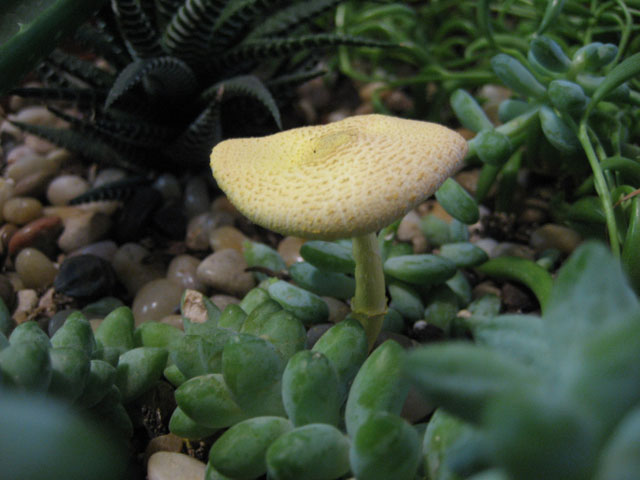
You have several reasons why mushrooms are growing on your potted plants, and the most immediate answer is that spores were probably present in your plant’s soil. Now, the next explanation is how they got in there.
Mushroom spurs are very light and can be caught by breeze or soft winds, hovering near or around your plant, and dropped to its soil. This has a high chance of happening anywhere- when the soil was being manufactured, in the garden nursery where it was bought, while the plant was on its shipment, or in the gardening center where you purchased it.
Another reason is that your plant mix is excessively rich. Mushrooms tend to thrive in nutritious soil where the spores easily germinate. There are particular potting mix brands that are known for cultivating mushrooms. If you are avoiding growing them, then avoid these brands.
Lastly, one of the possible reasons is that you may be overwatering your plants. This can be a problem, but there is a higher chance of getting molds than plant mushrooms if you are overwatering them. If you are a beginner in taking care of plants and think you may be overwatering, you can get a moisture meter to make things easier.
RELATED: How To Get Rid Of Mushrooms In Lawn | Are Mushrooms Harmful To Grass?
What Do Mushrooms Do For The Plant?
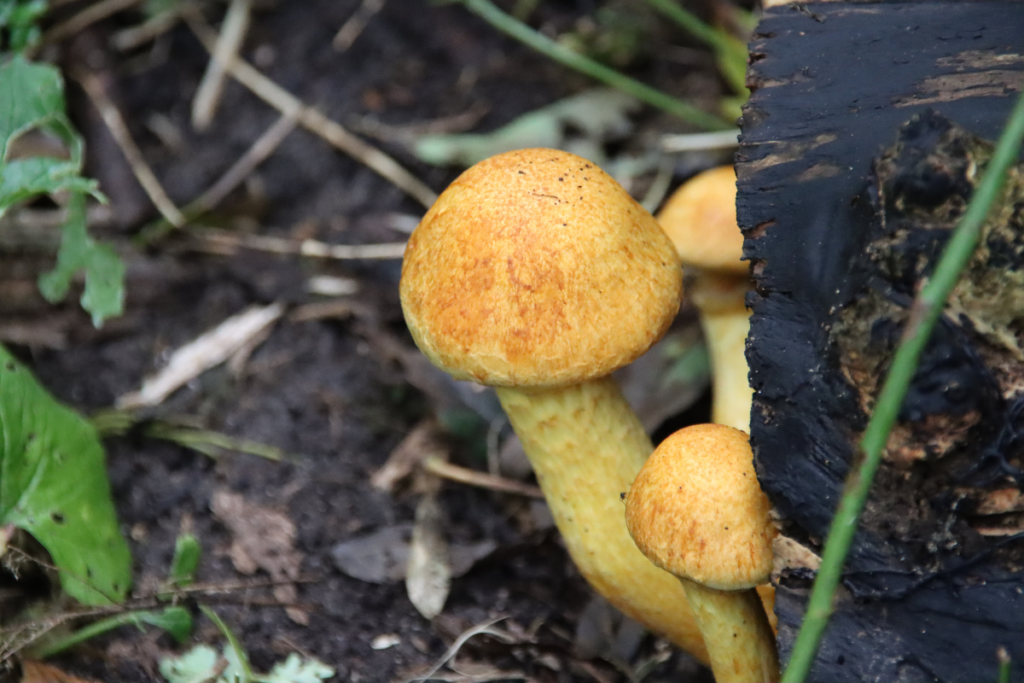
Some types of mushrooms have a parasitic relationship with plants. But there’s no need to worry because the ones in your pot mix are not one of them! Leucocoprinus brinbaumii is a saprotrophic mushroom, which simply means they feed on decaying, organic matter.
As mentioned above, plants and saprophytic mushrooms have a symbiotic relationship. The mushrooms feed on the pot’s dead roots and other decaying material, such as bugs or insects.
These then are broken down and released back into the soil that the plant can use as their source of nutrients. So basically, they benefit each other in a way that mushrooms have a place to grow on while the plant gets extra nutrients from the soil.
Do Mushrooms Pose A Danger To My Houseplants?
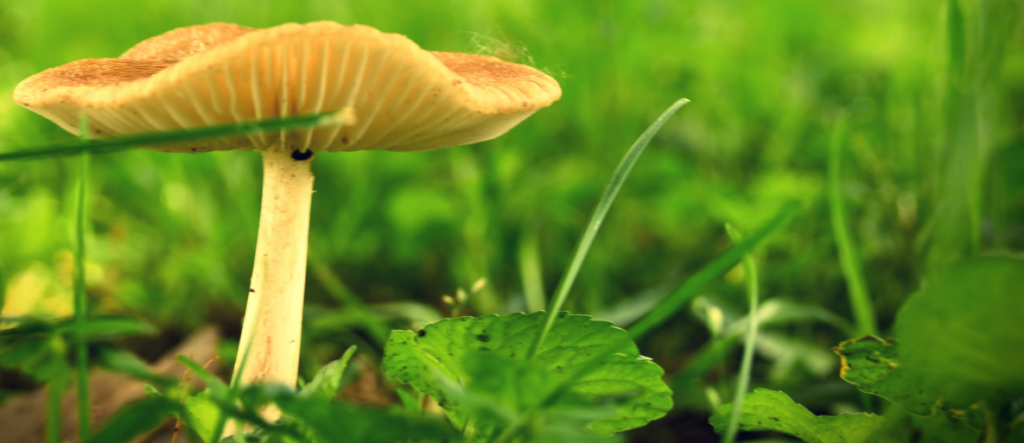
Again, there are different types of mushrooms that have different relationships with plants and other living things. Some are parasitic, which can cause your plant to suffer from lack of nutrients or lack of space and, worse, death. Parasitic fungi can be an incredibly destructive force, so it is also essential to be mindful when it comes to them.
One of the commonly encountered parasitic mushrooms is the Hypmyces lactifluorum, widely known as lobster claws. They are bright orange mushrooms that can be edible and usually feed on trees in rainforests or in damp environments, rarely on houseplants.
Now, going back to the mushrooms in your pot! With the given information above, and as long as they are not molds or don’t look like lobster claws, the answer would be NO. They bring no damage to your plant because they are saprophytic, which means they get their nutrition from dead matter. As a matter of fact, they are actually in competition with fungus gnats and not actually your plant.
However, it is crucial to take into consideration that Leucocoprinus brinbaumii spreads and reproduces via spores. If you ever found one, you might see yourself ending up with plenty of them. They hail from the tropical regions; hence, if you are living in a place with a colder climate, they will not reproduce as much as they can in warmer areas.
Are They Dangerous To Me?

You may think that if the mushrooms are not dangerous to your plants or other plants, they won’t be toxic to you. Probably, but it’s not always the case.
When you see mushrooms such as Leucocoprinus brinbaumii growing beside your herbs, vegetables, and crops, they have no effect on the toxicity or taste of your yield. The spores that flow via the air do not also cause a health concern. However, you may want to check on molds because they also thrive in similar conditions. As long as you avoid ingesting them, they are basically harmless.
Should I Remove The Mushrooms?
These mushrooms only pose threats when they are being ingested. They can cause irritations or some sort of reaction that the human body won’t appreciate.
And so, the answer is probably up to you. If mostly the people inside your home are adults, then you can probably keep them. Otherwise, if you own pets or have small children that might accidentally feast on them, removing these mushrooms or putting your contaminated plants somewhere out of reach is best. Some people also don’t like the look of them in their pots, and yes, they may also spread readily given the ideal environment.
How Do I Get Rid Of These Mushrooms In Your Plants?
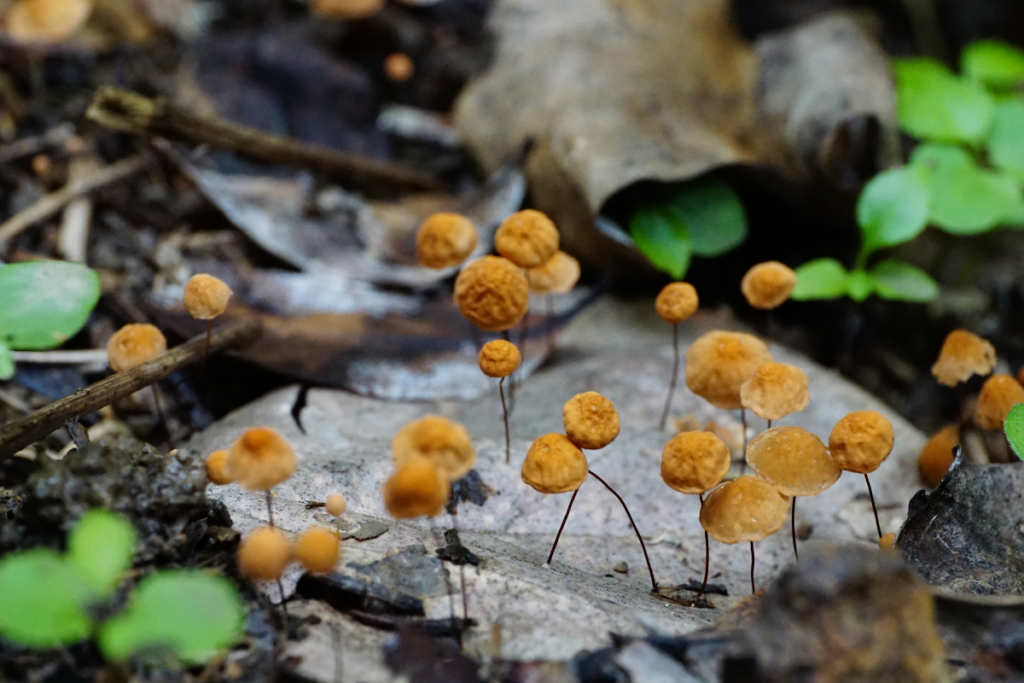
There are proper ways to remove mushrooms, especially the ones growing in your pots. However, if you ever decide to remove them, it is not always easy, especially if you live in warmer regions where air can easily hang around the air. You might also need to change your potting mix entirely if you plan to eliminate them.
To remove them, you simply pluck the mushrooms out as they appear. You can do this by holding on to the stem and not via the cap because chances are you’re just going to pull the mushroom cap off.
Another successful way to get rid of them is to repot your houseplant in a new potting soil. Or just remove the soil’s top half-inch, especially if repotting gives the plant too much compromise or stress.
Always make certain that when repotting, you clean and wash the plant pot thoroughly with warm, soapy water. To make sure that all of the spores have been removed, you can also add bleach. There are also commercially available fungicides if you really want to be specific.
Lastly, be informed that other plants have actual symbiotic fungi thriving at the roots. Removing these beneficial fungi may potentially inflict damage to the plant. So what plant experts recommend is to just pluck out mushrooms and leave them at that. After all, they are and can be signs of a healthy soil, so they are harmless.
Conclusion
In summary, mushrooms, specifically Leucocoprinus brinbaumii, that are found in your pots are not at all harmful and quite beneficial. They are saprophytic mushrooms that have an important relationship with your plant by breaking down nutrients from dead organic matter and returning them to the soil.
Although they are harmless, it is also important to be aware of other fungi that may be present along with them, especially in warmer climates, such as molds. In addition to that, they may also spread more easily in warmer regions compared to more temperate ones.
It is also important to remember to keep them out of reach from children and pets as they can be toxic when ingested. Just be sure to remove them properly, if you ever decide to, without compromising the health and status of your plant.
Editor’s Recommendations
How To Care for A Spider Plant? (Plant Care Answers and More)
7 Top Reasons Why Your Monstera Leaves Turn Yellow
What Is Leca and Is it Useful for Plants? All The Plant Care Questions and Answers







